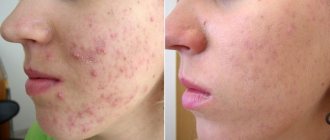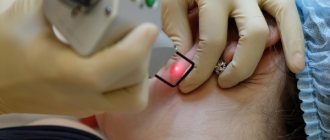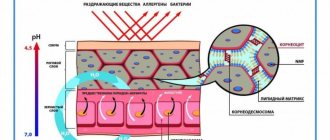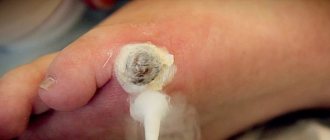Reasons for removing tumors
The laser method has replaced the electrosurgical method of combating growths. Skin neoplasms refer to a group of diseases that represent the proliferation of skin structures with the formation of qualitatively changed pathological cells. Superficially located benign neoplasms require removal. For some people this is caused by the desire to get rid of a cosmetic defect, for others it is a preventive measure against their spread.
But the most serious reason for removal is the danger of their transformation into a malignant tumor . This can be caused by minor trauma or intense sun exposure.
It is especially recommended to get rid of moles formed in the area of the feet and palms, in order to avoid their degeneration into melanoma.
The main reasons for radical removal of skin tumors are medical and cosmetic indications:
- Skin pathologies of a viral nature that cannot be self-healed: warts, genital warts, molluscum contagiosum.
- Skin growths that are subject to frequent trauma or friction. They are usually located in places such as the face, feet, armpits, and palms.
- Cosmetic defects in the form of moles, papillomas, keratomas.
Laser removal of moles, papillomas, stretch marks and scars
Genital warts appear due to a virus that is sexually transmitted. Laser removal will only be effective when combined with drug treatment.
| Procedure/zone | Price, in rubles |
| Initial doctor's appointment before treatment | 900,00 |
| Removal of genital warts of the external genitalia, for 1 piece. | 1 100,00 |
| Infiltration anesthesia, 1 ampoule | 400,00 |
all prices in the section Laser cosmetology prices
- All Promotions
- Consultation
- 900 rub. 0 rub.1
- 1 If the procedure is carried out on the day of consultation, see the conditions
- Sign up
Molluscum contagiosum are small, round, pinkish formations on the skin and mucous membranes, and on the eyelids they are millet-like small white formations. Their appearance is caused by a virus that penetrates through microtraumas. Self-removal may lead to re-infection. Marks after laser removal disappear within two days.
| Procedure/zone | Price, in rubles |
| Initial doctor's appointment before treatment | 900,00 |
| Removal of molluscum contagiosum, per 1 piece. | 490,00 |
| Infiltration anesthesia, 1 ampoule | 400,00 |
all prices in the section Laser cosmetology prices
- All Promotions
- Consultation
- 900 rub. 0 rub.1
- 1 If the procedure is carried out on the day of consultation, see the conditions
- Sign up
A sebaceous cyst, or atheroma, is a round, smooth formation. It is white or yellow in color and consists of condensed sebum. This formation can become inflamed, sometimes it empties spontaneously or after pressure. Laser removal is carried out using local anesthesia and lasts about five to twenty minutes. If the atheroma is large, then the wound is significant, requiring sutures. They are removed after a week.
Xanthelasmas are flat yellowish formations. They appear due to lipid metabolism disorders. Their usual location is the eyelids. The only way to remove them without leaving a trace is with a laser.
| Procedure/zone | Price, in rubles |
| Initial doctor's appointment before treatment | 900,00 |
| Removal of milleum, for 1 piece. (face) | 330,00 |
| Removal of milleum, for 1 piece. (body) | 250,00 |
| Removal of an ingrown nail, 1 side of the phalanx | 5 900,00 |
| Treatment with Kenalog, 1 ampoule | 2 200,00 |
| Infiltration anesthesia, 1 ampoule | 400,00 |
| Application anesthesia, 5 grams | 600,00 |
| Dressing | 600,00 |
all prices in the section Laser cosmetology prices
- All Promotions
- Consultation
- 900 rub. 0 rub.1
- 1 If the procedure is carried out on the day of consultation, see the conditions
- Sign up
The essence of the laser method
Before surgery, it is necessary to conduct a dermoscopic diagnosis. A dermatologist examines the tumor for the possibility of malignant degeneration. This procedure prevents the occurrence of melanoma.
It is important to consider that laser can only be used for aesthetic correction. For malignant neoplasms, a surgical method is required.
Anesthesia for laser treatment of a growth is not required, but can be provided at the request of the patient.
The laser beam always acts in a dosed and targeted manner. Even if the tumor has deep roots, the laser is directed only at the body of the growth. Its length is selected in accordance with the type of growth. The surrounding tissues remain intact. The energy of the laser beam activates healthy cells, causing them to divide more intensively. This leads to rapid healing of the wound left after the removed tumor. Just a week is enough for no traces to remain in the place of the former growth, only young and healthy skin.
The operation to remove a mole or wart is performed very quickly , in a matter of minutes. The method is based on layer-by-layer burning of the nevus. If the size of the tumor is small, then only one visit to the doctor will be required. The layers are removed until a micro-wound appears. A larger nevus requires several visits to the doctor's office, with mandatory intervals of several weeks. When performing a multi-stage operation, the doctor treats the wound with potassium permanganate and applies a sterile bandage.
The laser can get rid of any benign type of growth, regardless of its age and size : warts, papillomas, moles, fibromas, angiomas and many others. During the process, there is no contact of the instrument with the skin, which ensures the sterility of the wound. The operation is performed with different types of lasers, this factor depends on the degree of complexity of the growth.
The use of CO2 is a traditional laser technology based on the evaporation of pathological cells by ablation. There is also an erbium and neodymium laser that produces coagulation of blood vessels.
Oncology treatment methods
Modern methods of fighting cancer are built on the same principles; the basis of effective treatment is speed, safety and complexity.
You may be interested in: Cryosurgery against cancer: objectives, procedure and possible complications
Drug treatment
The use of drugs for the treatment of cancer patients is carried out taking into account the stage and location of the malignant process. Antitumor vaccines, hormonal and symptomatic drug therapy are used. Treatment with tablets and vaccines is not used as an independent method; it is only an addition to the main measures.
Chemotherapy
Chemotherapy is one of the main methods of treating malignant neoplasms, but is used in parallel with radical measures. The drugs that are used actively fight pathological cells. Healthy tissues are also negatively affected, but to a lesser extent. This selectivity of chemicals lies in the rate of cell growth. Cancerous structures multiply quickly, and they are the first to be hit by chemotherapy.
Surgical intervention
The surgical operation is aimed at truncation of the main focus of the tumor and nearby tissues. Surgery is appropriate only at the first, second and third stages of the disease. The last (fourth) stage of cancer cannot be treated with surgery, since at the 4th stage of cancer metastasis occurs, and it is impossible to remove all metastases from the body.
Radiation therapy (radiation)
Radiation therapy is appropriate when cancer cells are sensitive to this type of radiation. It is usually a small cell cancer that most often affects the respiratory system, uterus, brain, or lungs. Radiation is often performed before surgery to localize the main tumor site.
Palliative treatment
Palliative measures are aimed not at treatment, but at improving the quality and life expectancy of patients with stage 4 cancer. The essence of treatment comes down to the prescription of potent drugs that significantly alleviate the patient’s condition.
Indications and contraindications
There are several factors that should alert a person to seeing a doctor:
- mechanical damage to neoplasms;
- shape, size or color undergo changes;
- inconvenience caused by the tumor, discomfort as a result of its injury or inflammation;
- aesthetic unattractiveness of the tumor due to its location on open areas of the skin. For example, papillomas are most often removed due to aesthetic discomfort.
There are a number of reasons why laser tumor removal is contraindicated:
- acute respiratory infections;
- pregnancy;
- herpes in the acute stage;
- allergy;
- hypertensive crisis;
- fever;
- insulin diabetes mellitus;
- hemophilia;
- isolated cases of malignant neoplasms.
What should not be done after laser removal of papilloma?
Under no circumstances should you touch the wound with dirty hands, as this can lead to infection and slow down the recovery process.
It is not recommended to wet this area, which can also slow down rehabilitation. The fact is that when water gets on the problem surface, the crust takes much longer to form. This is why you should avoid contact with moisture when showering and bathing until a scab forms.
In the first 3-4 weeks after laser removal of papillomas, you should not sunbathe on the beach or visit a solarium; ultraviolet rays slow down the process of tissue regeneration and contribute to the appearance of scars. Moreover, you should not go outside in the summer without applying sunscreen.
If it is not clear what to do after removing papilloma with a laser, you should consult a doctor. But you should immediately pay attention to the fact that for a month from the date of the procedure you should avoid skincare cosmetics, especially tonics, lotions, and scrubs. The latter can damage the protective layer in the form of a scab, lead to the appearance of blood and prolong the recovery process over time. It is also undesirable to apply powder, tinting compounds, or blush if they are meant to come into contact with the problem area.
If the wart was located on the hands, then contact with household chemicals - powder and detergent - will be harmful, especially if they contain aggressive components. This can cause a burning sensation and lead to damage to the crust, causing redness and irritation, itching and swelling.
Note! It is very important how long the skin takes to heal after laser removal of papillomas. If after 2-3 weeks a scab does not appear in their place, you should urgently consult a doctor.
Advantages and disadvantages of laser removal of growths
The laser method has undeniable advantages over all other methods of surgical intervention. The operation is carried out at any time of the year. It is possible to get rid of tumors without a trace on any part of the body.
Main advantages:
- lack of invasion into the skin;
- minimal impact on healthy tissue due to the small beam diameter;
- the operation is almost completely painless and occurs without bleeding;
- suppuration of the wound after surgery is excluded;
- no relapses, pigmentation in the future;
- stimulation of skin tissue regeneration;
- the rehabilitation period ranges from 5 to 7 days, while it is allowed to lead a normal lifestyle, except for exposure to the sun;
- no scars, spots or pits are left;
- rapid healing, the remaining crust on the treated area disappears after 4-6 days;
- the short duration of the operation - only a few minutes are enough to remove the growth, and in one session you can get rid of several tumors at once;
- No hospital stay is required.
The disadvantage of the laser method is the inability to send a remote tumor for histology. In this regard, dermoscopic diagnosis is necessary before surgery.
Laser therapy
Laser therapy is one of the modern and safe ways to combat both benign and malignant tumors. Using a surgical laser, the surgeon and oncologist evaporate and destroy biological tissue with a mutated gene apparatus. Lasers can be used to reduce or eliminate any neoplasia. Laser treatment can also be used to relieve some symptoms of cancer, such as obstruction or heavy bleeding. Laser therapy is most effective for shrinking or eliminating tumors that affect the patient's trachea, esophagus, or to remove colon polyps or tumors that are blocking the stomach.
How does the procedure work?
A flexible endoscope equipped with optical fibers is inserted into one of the natural openings on the body (nose, mouth, anus or vagina). The laser light at the tip of the fiber increases the temperature of the tumor cells and damages or destroys them.
Photodynamic therapy (PDT) is one of the popular techniques in laser cancer treatment. In photodynamic therapy, the patient is injected with a special drug, a photosensitizer, which is absorbed by cells throughout the patient's body. After 1-2 days, the agent is found predominantly in cancer cells. Laser light is used to activate the agent and kill cancer cells.
Benefits of laser therapy
Despite the abundance of techniques used in the treatment of oncology, laser therapy has a number of undeniable advantages:
- minimal trauma to surrounding tissues;
- the laser is more accurate than many surgical instruments, such as a scalpel;
- shorter duration of manipulations;
- low likelihood of bleeding, scarring and swelling;
- Hospitalization is not always required;
- less risk of relapse.
Among the disadvantages of laser therapy compared to classical surgery, we can note the need for repeated treatment, since due to the short exposure time it is not always possible to eliminate the tumor completely.
Side effects
There are almost no warnings about laser surgery, since no side effects are observed. Main consequences:
- Photodermosis, an allergy to ultraviolet light, can respond to laser use with swelling and redness, and in very sensitive skin, blistering.
- In rare cases, a temporary or permanent change in skin pigmentation to a lighter or darker shade may be noticed.
- Diseases such as herpes or acne may require medication support. The same applies to too large areas of growth.
After the operation, it is necessary to avoid traumatic factors, including steaming the skin, removing crusts, and cosmetic procedures. Before the scab begins to fall off, it is recommended to treat the wound with an alcohol solution of calendula, a solution of furacillin or chlorhexidine. You should avoid wetting the wound for 5 days. Insolation should be excluded to a minimum. It is required to use products with high UV protection.
Laser removal of tumors is the least traumatic operation. Despite the large number of advantages and the almost complete absence of side effects, the cost of the procedure is affordable for most citizens.
Contraindications
The laser hair removal procedure has a fairly long list of contraindications. Patients suffering from:
- a cold at the time of the procedure;
- allergies;
- diabetes mellitus;
- varicose veins;
- oncological diseases of any stage;
- acute infectious diseases of any organs;
- acute inflammatory processes of the epidermis;
- chronic skin diseases such as psoriasis, eczema, herpes, etc.;
- tendency to form keloid scars.
Laser hair removal is not prescribed:
- persons under 18 years of age;
- women who are pregnant or lactating;
- If there is a cluster of moles on the skin on the face;
- in case of skin damage (scratches, burns, etc.) at the site of the intended procedure;
- If your hair is too light and gray (because the laser simply “will not see” it);
- when taking certain medications;
- If you have individual intolerance to the procedure;
- after a recent tan or with overly dark skin (in this case, excess skin melatonin increases the likelihood of getting a burn).











